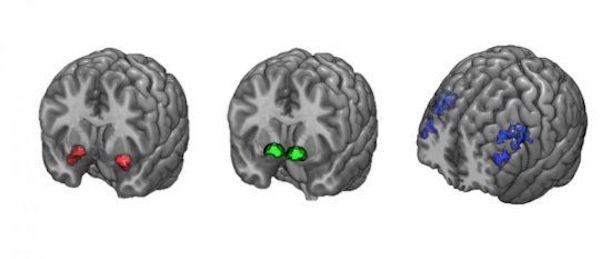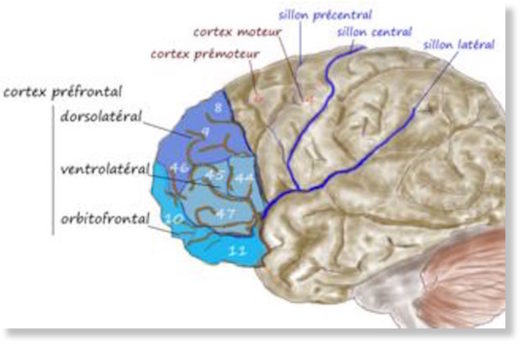
This pioneering discovery is noteworthy because it may bring clinicians one step closer towards tailoring psychological therapies for individual patients that target this specific region of the PFC. As an example, individuals whose brains exhibit the at-risk signatures of generalized anxiety disorders (GAD) may be more likely to benefit from strategies that boost the brain's dorsolateral prefrontal activity. These interventions could include cognitive behavioral therapy (CBT), working memory training, and/or transcranial magnetic stimulation (TMS).
For this study, the neuroscientists used fMRI brain imaging to assay the triad of (1) baseline threat-related amygdala, (2) reward-related ventral striatum, and (3) executive control-related prefrontal cortex activity. Each of the 120 young adult volunteers who participated in this study provided self-reported mood and anxiety ratings at baseline and at follow-up.
The final results showed a dynamic three-way interaction in which the combination of higher amygdala and lower ventral striatum activity predicted increases in anxiety for those with average or below-average DLPFC activity. However, as stated earlier, those with higher dorsolateral prefrontal activity and better executive control displayed fewer anxiety symptoms.

This Duke research team was led by Ahmad Hariri, who is director of the world-renowned Hariri Lab of NeuroGenetics and a professor of neuroscience and psychology. At the outset of this experiment, Hariri's team was curious to identify if higher activity in the dorsolateral prefrontal cortex could help shield anxiety-prone individuals from future mental health disorders. "We wanted to address an area of understanding mental illness that has been neglected, and that is the flip side of risk," Hariri said in a statement. "We are looking for variables that actually confer resiliency and protect individuals from developing problems."
The first author of this study, Matthew Scult, is a clinical psychology graduate student in the department of psychology and neuroscience at Duke and member of the Hariri Lab. Scult was particularly interested in "at-risk" individuals with the combination of high threat-related activity in the amygdala and low reward-related activity in the ventral striatum. By comparing participants' mental health assessments at the time of the brain scans-and then in a follow-up occurring on average seven months later - the researchers pinpointed that these at-risk individuals were less likely to develop anxiety if they specifically had high activity in DLPFC.
In the study's abstract, the authors write: "Our findings are consistent with the importance of top-down executive control in adaptive regulation of negative emotions, and highlight a unique combination of neural biomarkers that may identify at-risk individuals for whom the adoption of strategies to improve executive control of negative emotions may prove particularly beneficial."
Previous findings from Hariri's lab have shown that people whose brains exhibit a high response to threat and a low response to reward are more at risk of developing symptoms of anxiety and depression over time.
"These findings help reinforce a strategy whereby individuals may be able to improve their emotional - their mood, their anxiety, their experience of depression - not only by directly addressing those phenomena, but also by indirectly improving their general cognitive functioning," Ahmad Hariri said in a statement. "We found that if you have a higher functioning dorsolateral prefrontal cortex, the imbalance in these deeper brain structures is not expressed as changes in mood or anxiety."
Comment: Feelings and thoughts of anxiety, depression, and/or a tendency to go into 'fight or flight' mode can be greatly ameliorated byVagal Nerve stimulation. Use and practice breathing techniques described in the Éiriú Eolas program and see the difference.
There is one important caveat: Hariri and Scult emphasize that the jury is still out on whether specific brain-training exercises improve the overall functioning of the dorsolateral prefrontal cortex, or only hone its ability to complete the specific task being trained. They also warn that additional studies that include larger and more diverse populations are needed to confirm these preliminary findings.
"We are hoping to help improve current mental health treatments by first predicting who is most at-risk so that we can intervene earlier, and second, by using these types of approaches to determine who might benefit from a given therapy," Scult concluded. Stay tuned!
References
Scult, Matthew A., Annchen R. Knodt, Spenser R Radtke, Bartholomew D. Brigidi, Ahmad R. Hariri. "Prefrontal Executive Control Rescues Risk for Anxiety Associated with High Threat and Low Reward Brain Function" Cerebral Cortex (Published November 17, 2017) DOI: 10.1093/cercor/bhx304
Scult, Matthew A., Annchen R. Knodt, Johnna R. Swartz, Bartholomew D. Brigidi, and Ahmad R. Hariri. "Thinking and Feeling: Individual Differences in Habitual Emotion Regulation and Stress-Related Mood Are Associated with Prefrontal Executive Control." Clinical Psychological Science (First published online October 6, 2016) DOI: 10.1177/2167702616654688
Schaefer, Jonathan D., Matthew A. Scult, Avshalom Caspi, Louise Arseneault, Daniel W. Belsky, Ahmad R. Hariri, Honalee Harrington et al. "Is Low Cognitive Functioning a Predictor or Consequence of Major Depressive Disorder? A Test in Two Longitudinal Birth Cohorts." Development and Psychopathology (First published online: November 16, 2017) DOI: 10.1017/S095457941700164X



Reader Comments